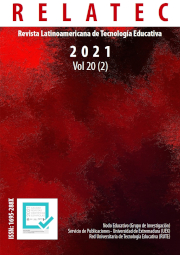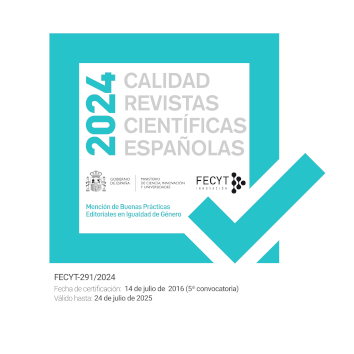Collaborative mobile educational technologies for blind students. A systematic review
DOI:
https://doi.org/10.17398/1695-288X.20.2.83Keywords:
M-learning, Blind students, Collaborative teaching, Mobile teaching apps, Teaching resourcesAbstract
Traditional teaching methods lose prominence as new technologies emerge as aids in the learning process. Ensuring new classroom dynamics and expanding the learning environment beyond the classroom is, in fact, a tempting additive for students who are developing in an era of technological ascension. Mobile learning or M-learning is, therefore, the most accessible and popular way to offer educational dynamics to students, including those with some type of disability. Bringing together collaborative teaching, which allows students to work in groups and interactively with each other, and the facilities provided by technology, the objective of the work is to present a systematic literature review pointing out the impact of collaborative mobile technologies for teaching people with Visual impairment. Following Kitchenham's systematic review method, 592 articles in Portuguese and English were analyzed, 10 of which were selected to answer the research questions. The results of this research reveal that the use of mobile technologies is efficient and more accessible, positively impacting the learning of students with visual impairments, but still presents latent problems and challenges. This systematic review provides the academic community with a current synthesis of research and development on the subject, between 2015 and 2020, in different teaching environments regarding the educational level and context, characteristics, receptivity and challenges, always backed up by empirical evidence.
Downloads
References
Brereton, P., Kitchenham, B. A., Budgen, D., Turner, M., & Khalil, M. (2007). Lessons from applying the systematic literature review process within the software engineering domain. Journal of Systems and Software, 80(4), 571-583.https://doi.org/10.1016/j.jss.2006.07.009
Brito, J. A., Amorim, R., De Souza Monteiro, B., Melo Filho, I. J., Gomes, A. S., De Oliveira, I. V. P., & da Rocha Seixas, L. (2017). Ubiquitous meaningful learning: Practices in the urban context. 2017 12th Iberian Conference on Information Systems and Technologies (CISTI), 1-7. https://doi.org/10.23919/CISTI.2017.7975874
Buzzi, M. C., Buzzi, M., & Leporini, B. (2012). Investigating mobile learning and accessibility for blind users. Mobile Learning for Visually Impaired People, 26.
Campbell, L. (2017). You don't need eyes to see, you need vision: performative pedagogy, technology and teaching art to students with vision impairment. Journal of Pedagogic Development, 7(3), 3-12.
Chinthaka, W., & Abeygunawardhana, P. (2018). Cbeyond: Mathematical Learning Tool for Primary Level Visual Impaired Students. 2018 13th International Conference on Computer Science & Education (ICCSE). https://doi.org/10.1109/ICCSE.2018.8468805
Crompton, H., & Burke, D. (2018). The use of mobile learning in higher education: A systematic review. Computers & Education, 123, 53-64. https://doi.org/10.1016/j.compedu.2018.04.007
Eguavoen, E. O. (2016). ICT Utilization As Correlates Of Academic Performance Among Students With Visual Impairment In Lagos State, Nigeria. European Scientific Journal, ESJ, 12(13), 205-205. https://doi.org/10.19044/esj.2016.v12n13p205
Guinness, D., Muehlbradt, A., Szafir, D., & Kane, S. K. (2018). The Haptic Video Player: Using Mobile Robots to Create Tangible Video Annotations. Proceedings of the 2018 ACM International Conference on Interactive Surfaces and Spaces, 203-211. https://doi.org/10.1145/3279778.3279805
Kane, S. K., Shinohara, K., & Wobbrock, J. (2015). OneView: Enabling Collaboration Between Blind and Sighted Students. Undefined. https://www.semanticscholar.org/paper/OneView%3A-Enabling-Collaboration-Between-Blind-and-Kane-Shinohara/562f0ffe9a1c5f812d0d326257fc2ce436407e8a
Kinash, S., Crichton, S., & Kim-Rupnow, W. S. (2004). A Review of 2000-2003 Literature at the Intersection of Online Learning and Disability. American Journal of Distance Education, 18(1), 5-19. https://doi.org/10.1207/s15389286ajde1801_2
MacLure, K., Paudyal, V., & Stewart, D. (2016). Reviewing the literature, how systematic is systematic? International Journal of Clinical Pharmacy, 38(3), 685-694. https://doi.org/10.1007/s11096-016-0288-3
Moloo, R. K., Khedo, K. K., & Prabhakar, T. V. (2018). Critical evaluation of existing audio learning systems using a proposed TOL model. Computers & Education, 117, 102-115. https://doi.org/10.1016/j.compedu.2017.10.004
Pacheco, E., Yoong, P., & Lips, M. (2017). The Role of ICTs in Students with Vision Impairments’ Transition to University (SSRN Scholarly Paper ID 3128786). Social Science Research Network. https://papers.ssrn.com/abstract=3128786
Pacheco, E., Yoong, P., & Lips, M. (2017, mayo 1). The Role of ICTs in Students with Vision Impairments’ Transition to University. International Conference on Information Resources Management - CONF-IRM2017, Rochester, NY. https://ssrn.com/abstract=3128786
Pesek, M., Kuhl, D., Baloh, M., & Marolt, M. (2015). ZaznajSpoznaj—A modifiable platform for accessibility and inclusion of visually-impaired elementary school children. Proceedings of the International Conference on Informatics in Schools—ISSEP 2015, 173-179. https://core.ac.uk/download/pdf/151478405.pdf#page=179ç
Rauch, M. (2011). Mobile documentation: Usability guidelines, and considerations for providing documentation on Kindle, tablets, and smartphones. 2011 IEEE International Professional Communication Conference, 1-13. https://doi.org/10.1109/IPCC.2011.6087221
Ravindran, V., & Shankar, S. (2015). Systematic reviews and meta-analysis demystified. Indian Journal of Rheumatology, 10(2), 89-94. https://doi.org/10.1016/j.injr.2015.04.003
Setiawan, D., Priambodo, B., Anasanti, M. D., Hazidar, A. H., Naf’an, E., Masril, M., Handriani, I., Nseaf, A. K., & Putra, Z. P. (2019). Designing a Multimodal Graph System to Support Non-Visual Interpretation of Graphical Information. Journal of Physics: Conference Series, 1339(1), 012059. https://doi.org/10.1088/1742-6596/1339/1/012059
Shi, L., Zhao, Y., & Azenkot, S. (2017). Markit and Talkit: A Low-Barrier Toolkit to Augment 3D Printed Models with Audio Annotations. Proceedings of the 30th Annual ACM Symposium on User Interface Software and Technology, 493-506. https://doi.org/10.1145/3126594.3126650
Zhang, L., & Nouri, J. (2018, abril). A Systematic Review of Learning and Teaching with Tablets. 14th International Conference Mobile Learning. https://eric.ed.gov/?id=ED590394
Downloads
Published
Issue
Section
License
Authors who publish in this journal accept the following conditions:
1. The Author retains copyright in the article. Upon acceptance of the article, the author shall grant to the Publisher the right of first publication of the article. with the dcoument registered with the Creative Commons Attribution-NonCommercial-NoDerivative 4.0 International (CC BY-NC-ND) license, which allows to third parties to use what is published whenever they mention the authorship of the work and the first publication in this journal.
2. Authors can make other independent and additional contractual agreements for the non-exclusive distribution of the article published in this journal (eg, include it in an institutional repository or publish it in a book) provided they clearly indicate that the work was published for the first time in this journal.
3. Authors are allowed and recommended to publish their work on the Internet (for example on institutional or personal pages) before and during the review and publication process, as it can lead to productive exchanges and a greater and faster diffusion of published work (see The Effect of Open Access).









